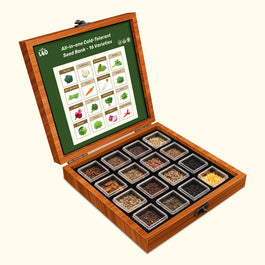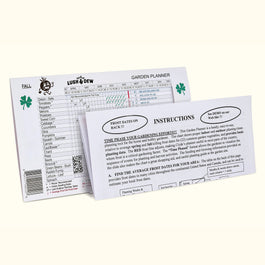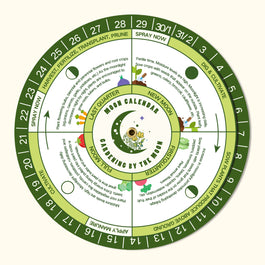Prepare your garden for winter and early spring blooms. Unlock the secrets of winter gardening with a selection of 16 robust varieties, carefully selected to thrive in cooler temperatures.
Why Fall is the Perfect Time to Garden
As the summer heat fades, fall offers a unique opportunity for gardeners to enjoy a productive growing season. The cooler weather, fewer pests, and ideal conditions for a wide range of crops make it the perfect time to get your hands dirty.
- Cooler Weather -
The crisp fall air reduces plant stress, allowing crops to grow stronger and more resilient. Cooler weather also means less watering and fewer pests, making gardening more enjoyable and less labor-intensive.
- Extended Harvest -
Fall gardening extends the growing season, allowing you to harvest fresh produce even in the colder months. Whether it’s leafy greens, root vegetables, or herbs, fall crops often have a more robust flavor.
- Soil Benefits -
The soil is still warm from summer, promoting quick germination and healthy root development. Adding organic matter in fall also improves soil structure and fertility, setting the stage for an even better garden next spring.
Choose the Best Seeds for a Thriving Fall Garden
Fall gardening is all about growing crops that thrive cooler weather and shorter days, ensuring a vibrant and productive garden well into the season.
- Leafy Greens -
Spinach, kale, and Swiss chard are staples of the fall garden. These leafy greens are resilient and fast-growing, providing a continuous supply of fresh, nutrient-rich leaves throughout the season.
- Root Vegetables -
Chemical pesticides and fertilizers can be harmful to pets if ingested or even if they come into contact with their skin. Opting for organic or pet-safe alternatives can help mitigate this risk.
- Cruciferous Vegetables -
Broccoli, cauliflower, and Brussels sprouts excel in cooler climates. These hardy vegetables form large, healthy heads that are packed with nutrients, making them a must-have for any fall garden.
- Hardy Herbs -
Cool-tolerant herbs like cilantro, parsley, and chives continue to flourish in the fall. These herbs not only enhance your garden's productivity but also add fresh, vibrant flavors to your fall dishes. They are easy to grow, even in containers.
Prepare Your Garden Beds for a Productive Fall Season
Properly preparing your garden beds is crucial for a successful fall garden. This preparation ensures that the soil is rich in nutrients, well-drained, and ready to support healthy plant growth.
Clear Out Summer Crops
Remove any leftover summer plants and weeds to reduce competition for nutrients and space, as well as the risk of pests and diseases that may affect fall crops.
Amend the Soil
Add compost or well-rotted manure to replenish the nutrients that were used up during the summer growing season. Fall crops thrive in nutrient-rich soil.
Test Soil pH
Use a soil test kit to check the pH of your soil. Most fall crops prefer a slightly acidic to neutral pH. Adjust the pH if necessary by adding lime to raise it or sulfur to lower it.
Improve Drainage
Ensure your garden beds have proper drainage to prevent waterlogging, which can harm fall crops. If needed, add organic matter like compost to improve soil structure.
Mulching
Apply a thick layer of organic mulch, such as straw or shredded leaves, to help retain moisture, regulate soil temperature, and suppress weeds.
Raised Beds
Consider using raised beds if your soil is heavy or poorly drained. Raised beds warm up faster and provide better drainage, making them ideal for fall planting.
Plant, Nurture, and Harvest Your Fall Garden
Once your garden beds are prepared, it's time to plant your fall crops. Careful planting and ongoing maintenance will ensure that your garden thrives throughout the season.
• Sowing Seeds: Sow seeds directly into the prepared garden beds following the recommended planting depth and spacing for each crop. Fall crops typically need less space than summer crops, so you can plant them closer together.
• Transplanting Seedlings: If you're starting with seedlings, plant them on a cool, cloudy day to reduce transplant shock. Water them thoroughly after planting to help them settle in.
• Watering: Fall crops still need regular watering, especially during dry spells. However, avoid overwatering as the cooler temperatures can lead to waterlogged soil. Water in the morning to allow the soil to dry out during the day.
• Frost Protection: As the temperatures drop, be prepared to protect your crops from frost. Use row covers or cloches to shield plants from early frosts, and consider mulching to insulate the soil.
• Pest Control: Pests are less of a problem in the fall, but you should still monitor your garden for signs of trouble. Use organic pest control methods, such as neem oil or insecticidal soap, to keep your plants healthy.
• Fertilizing: Fall crops generally require less fertilizer than summer crops, but a light application of a balanced fertilizer can support their growth. Avoid over-fertilizing, which can lead to lush foliage but poor harvests.
• Harvesting: Many fall crops can be harvested over an extended period. Leafy greens can be picked as needed, while root vegetables can be left in the ground until you're ready to use them. Be sure to harvest before a hard freeze.


























